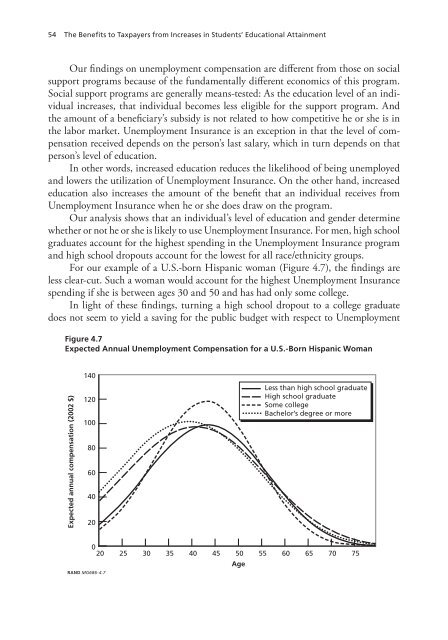The Benefits to Taxpayers from Increases in Students - RAND ...
The Benefits to Taxpayers from Increases in Students - RAND ...
The Benefits to Taxpayers from Increases in Students - RAND ...
Create successful ePaper yourself
Turn your PDF publications into a flip-book with our unique Google optimized e-Paper software.
54 <strong>The</strong> <strong>Benefits</strong> <strong>to</strong> <strong>Taxpayers</strong> <strong>from</strong> <strong>Increases</strong> <strong>in</strong> <strong>Students</strong>’ Educational Atta<strong>in</strong>ment<br />
Our f<strong>in</strong>d<strong>in</strong>gs on unemployment compensation are different <strong>from</strong> those on social<br />
support programs because of the fundamentally different economics of this program.<br />
Social support programs are generally means-tested: As the education level of an <strong>in</strong>dividual<br />
<strong>in</strong>creases, that <strong>in</strong>dividual becomes less eligible for the support program. And<br />
the amount of a beneficiary’s subsidy is not related <strong>to</strong> how competitive he or she is <strong>in</strong><br />
the labor market. Unemployment Insurance is an exception <strong>in</strong> that the level of compensation<br />
received depends on the person’s last salary, which <strong>in</strong> turn depends on that<br />
person’s level of education.<br />
In other words, <strong>in</strong>creased education reduces the likelihood of be<strong>in</strong>g unemployed<br />
and lowers the utilization of Unemployment Insurance. On the other hand, <strong>in</strong>creased<br />
education also <strong>in</strong>creases the amount of the benefit that an <strong>in</strong>dividual receives <strong>from</strong><br />
Unemployment Insurance when he or she does draw on the program.<br />
Our analysis shows that an <strong>in</strong>dividual’s level of education and gender determ<strong>in</strong>e<br />
whether or not he or she is likely <strong>to</strong> use Unemployment Insurance. For men, high school<br />
graduates account for the highest spend<strong>in</strong>g <strong>in</strong> the Unemployment Insurance program<br />
and high school dropouts account for the lowest for all race/ethnicity groups.<br />
For our example of a U.S.-born Hispanic woman (Figure 4.7), the f<strong>in</strong>d<strong>in</strong>gs are<br />
less clear-cut. Such a woman would account for the highest Unemployment Insurance<br />
spend<strong>in</strong>g if she is between ages 30 and 50 and has had only some college.<br />
In light of these f<strong>in</strong>d<strong>in</strong>gs, turn<strong>in</strong>g a high school dropout <strong>to</strong> a college graduate<br />
does not seem <strong>to</strong> yield a sav<strong>in</strong>g for the public budget with respect <strong>to</strong> Unemployment<br />
Figure 4.7<br />
Expected Annual Unemployment Compensation for a U.S.-Born Hispanic Woman<br />
140<br />
Expected annual compensation (2002 $)<br />
120<br />
100<br />
80<br />
60<br />
40<br />
20<br />
Less than high school graduate<br />
High school graduate<br />
Some college<br />
Bachelor’s degree or more<br />
<strong>RAND</strong> MG686-4.7<br />
0<br />
20 25 30 35 40 45 50 55 60 65 70 75<br />
Age
















